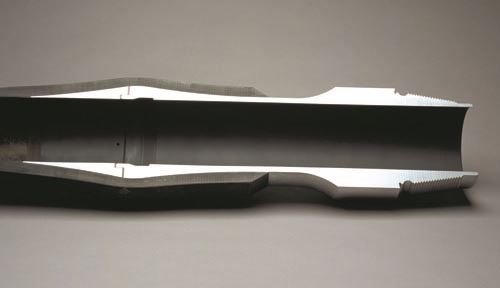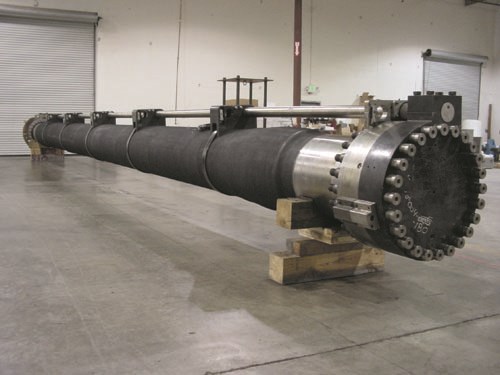Design Issues With Risers And Drill Pipe
The design characteristics of composites make them good material candidates for both risers and drill pipe. The high strength-to-weight ratio of composites means that they can be fabricated to withstand the same hydrostatic collapse pressures as steel, at a much lower weight — as much as 65 percent less on a p
The design characteristics of composites make them good material candidates for both risers and drill pipe. The high strength-to-weight ratio of composites means that they can be fabricated to withstand the same hydrostatic collapse pressures as steel, at a much lower weight — as much as 65 percent less on a pound-per-foot basis, according to a study performed by Chevron. The high cost of building and operating an offshore platform or vessel is influenced significantly by the weight of equipment — including risers — that must be supported on and below its deck. The use of lighter composite risers means that a lighter and smaller platform or vessel can be built with a lighter hull, with the same capacity, and at a lower cost. Alternatively, a platform that incorporates composite risers could potentially increase its capacity by being able to support more risers and tie-in subsea production from other fields, thus generating additional revenue.
While fairly inexpensive, steel catenary riser (SCR) systems have limitations in deep water, including high hang-off loads for floating production platforms. A composite riser is almost neutrally buoyant, says Lars Slagsvold of ABB Offshore Systems (Billingstad, Norway), which is good for minimizing hang-off loads, but can lead to problems of excessive movement due to first-order vessel motion. Additional weight might be needed in the riser string to minimize movement.
SCRs have a tendency to fail due to fatigue that is caused by compression along the catenary bend and by vortexinduced vibration (VIV). VIV is produced by the water currents that flow around the cylinders in the water, says Don Allen, research engineer with Shell International Exploration & Production. Friction along the cylinder surface slows the flow until a boundary layer forms between the slow moving water next to the pipe and the faster moving water or current away from the pipe. Standing vortex patterns are generated on both sides of the cylinder, and the vortex forming on one side of the cylinder becomes stronger than the vortex generated on the other side. Eventually the stronger vortex entrains the shear layer on the other side of the cylinder, and “sheds” away from the cylinder. Once the stronger vortex sheds it loses energy and becomes the weaker vortex, allowing the vortex on the other side to build, entrain, and shed. As this cycle continues, says Allen, it creates a lateral oscillating force, the frequency of which is related to the riser diameter and flow velocity of the current. Risers in the Gulf of Mexico are particularly susceptible to VIV because of the presence of deep currents that are created by loop currents coming off the Gulf Stream.
VIV is less problematic for composite riser systems. Composites have natural damping characteristics that can be enhanced by employing high-damping resins, says Dr. Su Su Wang, Director of Composites Engineering and Applications Center at the University of Houston. He points out that the reduced top tension required to support a composite riser, in contrast to a steel riser, reduces the riser’s lateral structural stiffness, making it less susceptible to VIV forces. Gawain Langford, riser system manager for ABB Offshore Systems, adds that the composite materials have a lower natural resonant frequency than steel.
Production risers must move large volumes of production at relatively high temperatures through cold seawater, and must be insulated to ensure that hydrate ices — ice crystals that form when hot extracted gas and oil cool and the water in them freezes — do not form and, consequently, block the flow. Composites have better insulating properties, which reduces the formation of hydrate ices. Plus, composites have excellent corrosion resistance to withstand seawater. “The biggest challenge for catenary riser configurations is flow assurance, and in cold seawater, it’s a challenge,” says Metin Karayaka of CSO Aker Engineering (Houston, Texas, U.S.A.). "It’s an area where composites can be used to advantage."
Risers are assembled in pieces, called “joints,” which vary in length from about 40 ft to 75 ft. Unlike joints of casing or drill pipe, which are threaded and screwed together, riser joints are connected using a high-pressure flange and several heavyduty bolts. The bolts are pre-tensioned to handle the loads that they experience in the water column. This tight connection also ensures against leakage from either the normal high-pressure flow of fluids inside the riser or a potential gas release from the drilled formation. For these reasons, joining composite tubulars is always a critical design issue. Steel or titanium connectors or end fittings are usually used, says Donald Baldwin of Lincoln Composites (Lincoln, Neb., U.S.A.), especially for applications where high loads are expected. The joints must absorb not only axial loads but bending stresses induced by water currents and the movement of the vessel or platform overhead. A critical element is the design of the load transfer mechanism between the composite tube body and the metal fitting. A well-designed metal-to-composite interface (MCI) is essential for a successful composite riser application.
An important requirement for advancing the offshore application of composite risers is the availability of a reliable in-service inspection system. Because composites are built up in layers, electrical cable or even fiberoptic lines can be incorporated into the laminate. Conoco has embedded fiberoptic sensors into its riser to measure critical factors such as strain so that degradation of the riser can be anticipated. ABB Vetco Gray (Houston, Texas, U.S.A.) uses acoustic emission technology to identify the acoustic “signature” of the riser. A change in this signature indicates potential degradation of the composite.
One issue is that the facilities are simply not yet in place to mass-produce volumes of composite tubulars for ultra deepwater applications, notes Dr. Mamdouh Salama, senior research fellow for production technology at Conoco. To compete with steel risers, composite products must not only come down in price, but must be deliverable in about the same time frame as a steel riser, as well.
Read Next
All-recycled, needle-punched nonwoven CFRP slashes carbon footprint of Formula 2 seat
Dallara and Tenowo collaborate to produce a race-ready Formula 2 seat using recycled carbon fiber, reducing CO2 emissions by 97.5% compared to virgin materials.
Read More“Structured air” TPS safeguards composite structures
Powered by an 85% air/15% pure polyimide aerogel, Blueshift’s novel material system protects structures during transient thermal events from -200°C to beyond 2400°C for rockets, battery boxes and more.
Read MoreDeveloping bonded composite repair for ships, offshore units
Bureau Veritas and industry partners issue guidelines and pave the way for certification via StrengthBond Offshore project.
Read More























